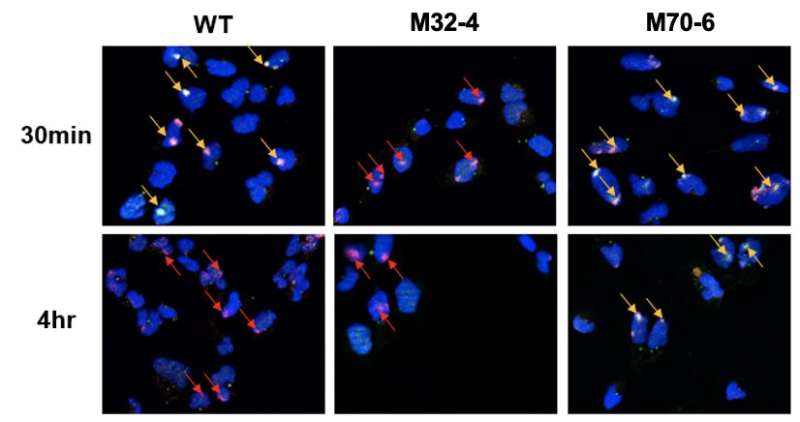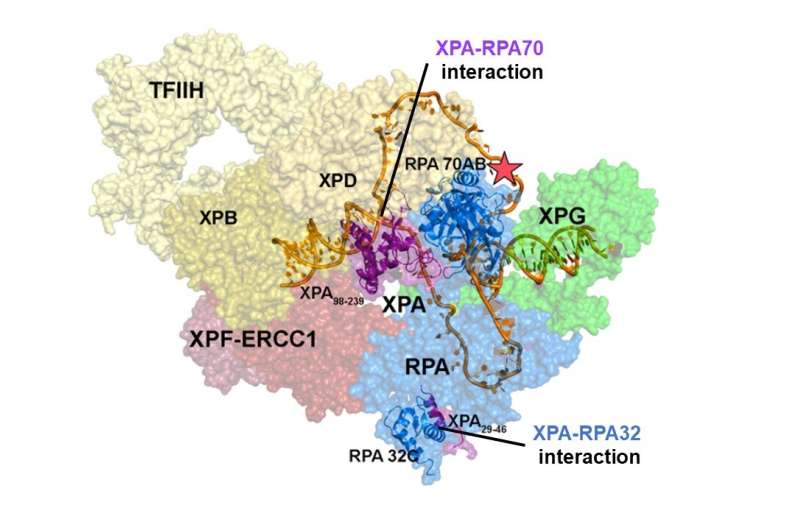Scientists achieve a new understanding of the nucleotide excision repair process

Nucleotide excision repair (NER) is a major conserved DNA repair pathway, which repairs various types of damage in the genome, such as those induced by ultraviolet light and environmental agents. Dysfunction in this pathway can be detrimental to human health. For example, individuals with defects in NER suffer from xeroderma pigmentosum, a disease characterized by an extreme disposition to sunlight-induced skin cancer due to an inability to repair UV-damaged DNA.
While NER thus counteracts cancer formation, it is also important for antitumor therapy. Many antitumor agents, such as cisplatin, induce damage to DNA that can be repaired by NER. In this context, NER is a drug target of interest to improve cancer therapy outcomes. At the molecular level, NER is a highly complex and dynamic molecular machine, involving over 30 proteins that assemble at DNA lesions to excise the damage and replace it with intact DNA. This process is guided by protein-protein and protein-DNA interactions.
A team of researchers led by the Associate Director Orlando D. Schärer and graduate student Kim Mihyun of the Center for Genomic Integrity within the Institute for Basic Science, South Korea explored these interactions. The team found that two key proteins in NER, namely xeroderma pigmentosum protein A (XPA) and replication protein A (RPA) proteins, are required for organizing the pre-incision complex in NER.
The two proteins XPA and RPA are responsible for the organization of the NER complex after it has found the damage in DNA. The present study compared mutant variants of these two proteins to investigate how the two proteins engage in a pivotal interaction for the NER pathway. Specifically, it was discovered that two interaction interfaces between XPA and RPA are critical for NER and have distinct roles in the pathway. The interaction of XPA with RPA32 is crucial for the initial association of XPA with DNA damage, whereas the interaction between XPA and RPA70 is important for the completion of NER.

Integrative structural studies of an XPA-RPA-DNA complex revealed how the interactions of the two proteins shape the NER complex and trigger excision of the damage. The interaction of XPA and RPA32 occurs at the periphery of the complex, where it facilitates the initial assembly of the proteins at the site of damage. The interaction between XPA and RPA70 is located at the heart of the NER complex and forces the DNA into a U-shape. This allows the two ss/dsDNA junctions to become localized in close proximity, allowing for the NER complex to incise the DNA to remove the damage.
Schärer stated that their "study revealed a surprising new model of the NER complex and how the interaction between XPA and RPA shapes its architecture. Disruption of the interaction between XPA and RPA inhibits NER, and our study provides a blueprint for how this interaction may be targeted by small molecules to improve cancer therapy. We are continuing to pursue follow-up research together with our long-term collaborator on this project, Prof. Walter Chazin at Vanderbilt University."
This research was published in Proceedings of the National Academy of Sciences.
More information: Mihyun Kim et al, Two interaction surfaces between XPA and RPA organize the preincision complex in nucleotide excision repair, Proceedings of the National Academy of Sciences (2022). DOI: 10.1073/pnas.2207408119
Journal information: Proceedings of the National Academy of Sciences
Provided by Institute for Basic Science



















